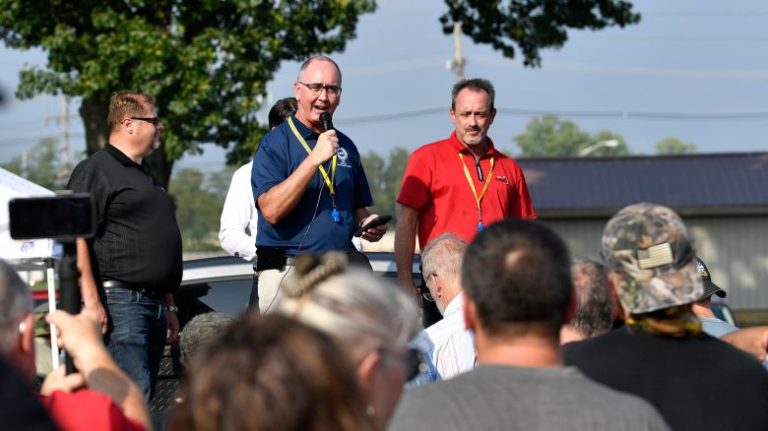United Auto Workers President Shawn Fain announced a targeted strike plan Wednesday if the union decides to walk out at General Motors, Ford and Stellantis after a contract expiration late Thursday.
Details of the plan, including which plants will be struck, will not be announced until just before the 11:59 pm contract expiration on Thursday night, Fain said. He said that this move would give the union the maximum leverage at the bargaining table.
A targeted strike could shut operations for each company, depending on which plants and facilities are struck. The companies operate a complex network of plants that are dependent on getting parts from different facilities. Slowing or stopping the production of a few engine or transmission plants at each company could be as effective at stopping operations as a full strike at all plants, according to industry experts.
One engine or transmission location per company might be enough to shut down nearly three-quarters of the US assembly plants, said Jeff Schuster, global head of automotive for GlobalData, an industry consultant.
“Two plants per company, you can pretty much idle North America,” he said.
Effects on a strike fund
One advantage for the union of a targeted strike is the potential to save resources and extend a possible strike. The union members who are on strike are eligible for $500 a week in strike benefits from the union’s strike fund. If all 145,000 UAW members among the three automakers were to strike at the same time, it could cost the fund more than $70 million a week, draining the $825 million fund.
With targeted strikes, it’s possible that the companies will shut down operations and lay off members who are not technically on strike. That could make them eligible to receive state unemployment benefits rather than strike benefits, which could preserve the union’s resources. But there are legal questions about qualifying for unemployment.
All three automakers issued statements that did not address what they planned to do if their operations are disrupted by a targeted strike.
“We continue to bargain directly and in good faith with the UAW and have presented additional strong offers, GM said in a statement. “We are making progress in key areas that we believe are most important to our represented team members.”
“We are here and ready to reach a deal. We should be working creatively to solve hard problems rather than planning strikes and PR events,” said Ford CEO Jim Farley in his company’s statement. “The future of our industry is at stake. Let’s do everything we can to avert a disastrous outcome.”
“We’re still awaiting the UAW’s response to the offer we presented yesterday,” said the statement from Stellantis. “Our focus remains on bargaining in good faith to have a tentative agreement on the table before the collective bargaining agreement expires.”
Fain did tell members that all three automakers had raised their wage increase offers to between 17.5% to 20% during the life of the contract, but he said that is still not sufficient. The union had originally requested an immediate 20% pay hike and four additional pay increases of 5%.
“We are seeing movement from the companies,” he said, but there are still many issues where the companies and the unions are far apart. He suggested a strike is likely.
“We do not yet have offers on the table that reflect the sacrifice and contributions our members have made to these companies,” he said. “We’re likely going to have to take action.”
‘A very risky strategy’
Fain told members Wednesday that it will be important for members to stay on the job if their plant is not chosen for a strike to give union negotiators the greatest possible power at the bargaining table.
“This is going to create confusion for the companies. It’s going to turbo charge the power of our negotiators,” he told members. “I know there’s a hunger to [have all members] go on strike. That may still happen. This was not done on a whim.”
The targeted strikes also could come with risk. Fain said workers who stay on the job will be employed under an expired contract and that the union is not offering those companies that are being struck an extension. The companies are not obligated to pay employees working under an expired contract.
“Letting your contract lapse and then undertaking strategic strikes is a very risky strategy because when you don’t have a contract, neither does the employer. There is no obligation for them to employ you. So it’s an escalation, not a de-escalation,” said Patrick Anderson, founder of the Anderson Economic group, a Michigan-based firm that has been doing analysis on the financial impacts of strikes for decades.
John Hatline, who has worked at General Motors for 49 years and has seen his fair share of strikes, told CNN he thought targeted strikes can work.
“We have used targeted strategies in the past. They have proven effective in helping resolve our contract disputes,” said Hatline, who works at GM’s Factory Zero in Detroit, which builds all electric vehicles. “It saves depletion of our strike fund. Without a substantial strike fund our bargaining power is reduced. When you enter a contract dispute you have to be willing to last one day longer than the company. Or all our sacrificing is for naught.”
— CutC by cnn.com


